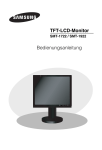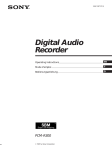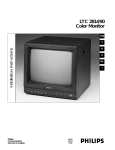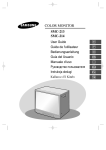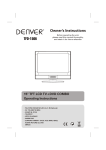Download American Dynamics ADMCRT15 User's Manual
Transcript
COLOR MONITOR ADMCRT15 User Guide Mode d’emploi Bedienungsanleitung Manuale dell'utente Guía del usuario IMPORTANT SAFETY INSTRUCTIONS 1. 2. 3. 4. 5. 6. 7. 8. 9. 10. 11. 12. 13. 14. Read these instructions. Keep these Instructions. Heed all warnings. Follow all instructions. Do not use this apparatus near water. Clean only with dry cloth. Do not block any ventilation openings. Install in accordance with the manufacturer’s instructions. Do not install near any heat sources such as radiators, heat registers, stoves, or other apparatus (including amplifiers) that produce heat. Do not defeat the safety purpose of the polarized or grounding-type plug. A polarized plug has two blades with one wider than the other. A grounding type plug has two blades and a third grounding prong. The wide blade or the third prong are provided for your safety. If the provided plug does not fit into your outlet, consult an electrician for replacement of the obsolete outlet. Protect the power cord from being walked on or pinched particularly at plugs, convenience receptacles and the point where they exit from the apparatus. Only use attachment/accessories specified by the manufacturer. Use only with the cart, stand, tripod, bracket or table specified by the manufacturer or sold with the apparatus. When a cart is used, use caution when moving the cart/apparatus combination to avoid injury from tip-over. Unplug this apparatus during lightning storms or when unused for long periods of time. Refer all servicing to qualified service personnel. Servicing is required when the apparatus has been damaged in any way, such as power-supply cord or plug is damaged, liquid has been spilled or objects have fallen into the apparatus the apparatus has been exposed to rain or moisture does not operate normally or has been dropped. Eng-2 CAUTION RISK OF ELECTRIC SHOCK DO NOT OPEN CAUTION : TO REDUCE THE RISK OF ELECTRIC SHOCK, DO NOT REMOVE COVER (OR BACK). NO USER SERVICEABLE PARTS INSIDE. REFER SERVICING TO QUALIFIED SERVICE PERSONNEL. Graphic Symbol Explanation The lightning flash with arrowhead symbol, within an equilateral triangle, is intended to alert the user to the presence of uninsulated ‘dangerous voltage’ within the product’s enclosure that may be of sufficient magnitude to constitute a risk of electric shock to persons. The exclamation point within an equilateral triangle is intended to alert the user to the presence of important operating and maintenance (servicing) instructions in the literature accompanying the appliance. Warning - To Prevent Fire or Shock Hazard, Do Not Expose This Monitor To Rain or Moisture. Eng-3 IMPORTANT SAFEGUARDS Caution Power source is indicated on the rear of the set. It contains high-voltage parts. If you remove the cover, it may cause fire or electric shock. Do not remove the cover by yourself. (Control switches are at the front of the monitor.) 1. Read Instructions : All the safety and operating instructions should be read before the appliance is operated. 2. Retain Instructions : The safety and operating instructions should be retained for future reference. 3. Heed Warnings : All warnings on the monitor and in the operating instructions should be adhered to. 4. Follow Instructions : All operating and user instructions should be followed. 5. Cleaning : Unplug this monitor from the wall outlet before cleaning. Do not use liquid cleaners or aerosol cleaners. Use a damp cloth for cleaning. Exception. A monitor that is meant for uninterrupted service and that for some specific reason, such as the possibility of the loss of an authorization code for a CATV converter is not intended to be unplugged by the user for cleaning or any other purpose may exclude the reference to unplugging the monitor in the cleaning description otherwise required in Item 5. 6. Attachments : Do not use attachments not recommended by AD(AMERICAN DYNAMICS) as they may cause hazards. 7. Water and Moisture : Do not use this monitor near water for example, near a bathtub, wash bowl, kitchen sink or laundry tub in a wet basement or near a swimming pool and the like wet basement or near a swimming pool and the like. Eng-4 8. Accessories : Do not place this monitor on an unstable cart, stand, tripod, bracket or table. The monitor may fall, causing serious injury to a child or adult and serious damage to the appliance. Use only with a cart, stand, tripod. bracket or table recommended by AD(AMERICAN DYNAMICS) or sold with the monitor. Any mounting of the monitor should follow AD(AMERICAN DYNAMICS)’s instructions and should use a mounting accessory recommended by AD(AMERICAN DYNAMICS). 9. Ventilation : Slots and openings in the cabinet are provided for ventilation and to ensure reliable operation of the monitor and to protect it from overheating and these openings should never be blocked by placing the monitor on a bed, sofa, rug or other similar surface. This monitor should never be placed near or over a radiator or heat register. This monitor should not be placed in a built-in installation such as a bookcase or rack unless proper ventilation is provided or AD(AMERICAN DYNAMICS)’s instructions have been adhered to. 10. Power Sources : This monitor should be operated only from the type of power source indicated on the making label. If you are not sure of the type of power supply to your installation site, consult your AD(AMERICAN DYNAMICS) dealer or local power company. 11. Grounding or Polarization : For monitors equipped with a 3-wire grounding-type plug having a third(grounding) pin. This plug will only fit into a grounding type power outlet. This is a safety feature. If you are unable to insert the plug into the outlet, contact your electrician to replace your obsolete outlet. Do not defeat the safety purpose of the grounding-type plug. 12. Power : Cord Protection-Power supply cords should be routed so that they are not likely to be walked on or pinched by items placed upon or against them, paying particular attention to cords at plugs, convenience receptacles and the point where they exit from the monitor. Eng-5 13. Lightning : For added protection for this monitor during a lightning storm or when it is left unattended and unused for long periods of time, unplug it from the wall outlet and disconnect the cable system. This will prevent damage to the monitor due to lightning and power-line surges. 14. Overloading : Do not overload wall outlets and extension cords as this can result in a risk of fire of electric shock. 15. Object and liquid Entry : Never push objects of any kind into this monitor through openings as they may touch dangerous voltage points or short-out parts that could result in a fire or electric shock. Never spill liquid of any kind on the monitor. 16. Servicing : Do not attempt to service this monitor yourself as opening or removing cover may expose you to dangerous voltage or other hazards. Refer all servicing to qualified service personnel. 17. Damage Requiring Service : Unplug this monitor from the wall outlet and refer servicing to qualified service personnel under the following conditions. a. When the power-supply cord or plug is damaged. b. If liquid has been spilled or objects have fallen into the monitor. c. If the monitor has been exposed to rain or water. d. If the monitor does not operate normally by following the operating instructions. Adjust only those controls that are covered by the operating instructions as an improper adjustment of other controls may result in damage and require extensive work by a qualified technician to restore the monitor to its normal operation. e. If the monitor has been dropped or the cabinet has been damaged. f. When the monitor exhibits a distinct change in performance-this indicates a need for service. Eng-6 18. Replacement Parts : When replacement parts are required, be sure the service technician has used replacement parts specified by AD(AMERICAN DYNAMICS) or have the same characteristics as the original parts. Unauthorized substitutions may result in fire, electric shock or other hazards. 19. Safety Check : Upon completion of any service or repairs to this monitor, ask the service technician to preform safety checks to determine that the monitor is in proper operating condition. Eng-7 Contents IMPORTANT SAFETY INSTRUCTIONS .................Eng-2 IMPORTANT SAFEGUARDS................................... Eng-4 Front Panel Components and Controls ........................ Eng-9 • Using buttons on the front panel ............................Eng-9 Rear Panel Components and Controls ....................... Eng-11 Connections ............................................................... Eng-12 Maintenance................................................................Eng-13 Specifications..............................................................Eng-14 Eng-8 Front Panel Components and Controls Using buttons on the front panel Power Switch On/off switch. If you press this button, the monitor is turned on and the LED of selected input signal is lit. VIDEO Input Selection Switch It selects video and audio input signal. To change input signal, press this button. VOLUME, DATA Control Switch VOLUME key has two functions : • Volume Controls • Data Controls : To change volume, press only this key. : If you press CONTRAST, BRIGHT, COLOR, TINT or SHARP and then VOLUME key, you can change the value of each key. Eng-9 CONTRAST Switch This control adjusts the contrast of the screen image. Press CONTRAST switch and then VOLUME(DATA) switch to control the contrast. BRIGHT Switch This control adjusts the bright of the screen image. Press BRIGHT switch and then VOLUME(DATA) switch to control the bright. COLOR Switch This control adjusts the color intensity of the screen image. Press COLOR switch and then VOLUME(DATA) switch to control the color intensity. TINT Switch With this switch, you can control the color to be close to natural color. For the best result, control screen image with this switch so that skin color is natural. Press TINT switch then VOLUME(DATA) switch to control the color. (Only NTSC) SHARP Switch This control adjusts the sharpness of the screen image. Press SHARP switch and then VOLUME(DATA) switch to control the sharpness. Eng-10 Rear Panel Components and Controls VIDEO LINE IN(A, B) Camera INPUT connector. Input connectors for up to 2 cameras VIDEO LINE OUT(A, B) Monitor OUTPUT connector. VCR IN(VIDEO) VCR INPUT connector. Connect to the VCR. AUDIO LINE IN(A, B) AUDIO INPUT connector. Select corresponding AUDIO input signals AUDIO LINE OUT(A, B) AUDIO OUTPUT connector. AUDIO IN (VCR) VCR AUDIO INPUT connector. Eng-11 Connections CCD Camera 1 CCD Camera 2 Eng-12 Maintenance If the quality of the picture on the COLOR MONITOR is poor and cannot be improved, inspect all system connections and cable runs. Repairs should be performed by a qualified technician with adequate test equipment and facilities. Eng-13 Specifications System ADMCRT15 (NTSC/PAL) CRT 15” diagonal, 0.6mm stripe pitch, 90° deflection Video In/Out 2 Channel Input/2 Channel Output. VCR INPUT 1.0Vp-p BNC jack Audio In/Out 2 Channel Input/2 Channel output. VCR Input RCA jack Power Source Control range of main section 100V~250V or “Indicated on the rear of the MONITOR set” Power Consumption 50W Dimensions (W x D x H) 365mm x 391mm x 342mm (without packing) Weight about 16.5Kg (with packing) Resolutions 400 TV lines Video System Multiple system (NTSC/PAL) Horizontal Stabilization Pull in Range ± 500Hz Holding Range ± 500Hz Vertical Stabilization Pull in Range ± 4Hz Holding Range ± 4Hz Sub Carrier Stabilization Pull in Range ± 400Hz Holding Range ± 400Hz Audio 1.5Watts Convergence Less than 0.4mm Max (Center) Overscan 10% Operating Temperature 0°C ~ +40°C Operating Humidity 10 ~ 90% (Non-condensing) Eng-14 COLOR MONITOR ADMCRT15 Mode d’emploi ATTENTION RISQUE DE DECHARGE ELECTRIQUE NE PAS OUVRIR ATTENTION : POUR REDUIRE LE RISQUE DE DECHARGE ELECTRIQUE, NE RETIREZ PAS LE CACHE (NI LE PANNEAU ARRIERE). AUCUNE PIECE NE PEUT ETRE REPAREE PAR L’UTILISATEUR. ADRESSEZ-VOUS AU PERSONNEL QUALIFIE POUR LE DEPANNAGE. Explication des symboles graphiques L'éclair et son extrémité en forme de flèche dans un triangle équilatéral sont destinés à alerter l’utilisateur de la présence d’une ‘tension électrique dangereuse’ non isolée à l'intérieur du produit, d’une intensité suffisamment importante pour constituer un risque de décharge électrique pour les êtres humains. Le point d’exclamation dans un triangle équilatéral est destiné à avertir l’utilisateur de l’existence de consignes importantes d’utilisation et d’entretien (dépannage) dans la documentation accompagnant l’appareil. Avertissement – Pour éviter les risques d'incendie ou de décharge électrique, n'exposez pas ce moniteur à la pluie ou à l'humidité. Fra-2 CONSIGNES IMPORTANTES Attention Le point d’alimentation est indiqué à l’arrière de l'appareil. Il contient des pièces sous haute tension. Si vous retirez le couvercle, un incendie ou une décharge électrique risque de se produire. Ne retirez pas vous-même le couvercle. (Les boutons de commande sont situés à l'avant du moniteur). 1. Lisez les consignes : Vous devez prendre connaissance de toutes les consignes de sécurité et d’utilisation avant la mise en marche de l’appareil. 2. Conservez les consignes : Les consignes de sécurité et d’utilisation sont à conserver en vue d’une consultation ultérieure. 3. Tenez compte des avertissements : Tous les avertissements figurant sur le moniteur et dans les consignes d’utilisation doivent être pris en compte. 4. Suivez les consignes : Toutes les consignes d’utilisation doivent être suivies. 5. Nettoyage : Débranchez le moniteur de la prise d’alimentation avant de le nettoyer. N’utilisez pas de produits de nettoyage liquides ou en aérosol. Utilisez un chiffon humide pour le nettoyage. Exception. Dans le cas d’un moniteur destiné à fonctionner en continu et excluant, pour des raisons telles que le risque de perdre le code d’autorisation d’un convertisseur de télévision par câble, tout débranchement de la part de l’utilisateur en vue d’un nettoyage ou pour toute autre raison, il peut arriver que le débranchement du moniteur ne soit pas mentionné dans la description du nettoyage qui autrement est requise au point 5. 6. Accessoires : N’utilisez pas d’accessoires non recommandés par AD(AMERICAN DYNAMICS), car ils peuvent se révéler dangereux. 7. Eau et humidité : N’utilisez pas ce moniteur à proximité de source d’eau, par exemple à proximité d’une baignoire, d’un lavabo, d’un évier, d’un bac de lavage, dans un sous-sol humide ou près d’une piscine, etc. Fra-3 8. Accessoires : Ne placez pas ce moniteur sur un chariot, un socle, un trépied, une console ou une table instable. La chute du moniteur pourrait blesser grièvement un enfant ou un adulte et gravement endommager l'appareil. Utilisez uniquement un chariot, un socle, un trépied, une console ou une table recommandé(e) par le fabricant ou vendu(e) avec le moniteur. Suivez les consignes de AD(AMERICAN DYNAMICS) lors du montage du moniteur et utilisez l'accessoire de montage recommandé par AD(AMERICAN DYNAMICS). 9. Ventilation : Dans le châssis, les fentes et les ouvertures assurent la ventilation et le bon fonctionnement du moniteur, lui évitant ainsi les risques de surchauffe ; n’obstruez jamais ces ouvertures en plaçant le moniteur sur un lit, un canapé, un tapis ou toute autre surface similaire. Ne placez pas le moniteur à proximité ou au-dessus d'un radiateur ou d'un registre de chaleur. Ne placez pas le moniteur dans un meuble encastré comme une bibliothèque ou une étagère sauf dans le cas où une ventilation adéquate est prévue ou si vous vous conformez aux consignes de AD(AMERICAN DYNAMICS). 10. Sources d'alimentation : Raccordez ce moniteur uniquement à la tension d'alimentation indiquée sur l'étiquette. Si vous n'êtes pas sûr de la tension d'alimentation du lieu d’installation, consultez votre revendeur AD(AMERICAN DYNAMICS) ou votre fournisseur d'électricité local. 11. Prise de terre ou polarisation : Pour les moniteurs équipés d’une prise de type mise à la terre 3 conducteurs avec une troisième broche (de mise à la terre). Cette prise ne peut être branchée que dans une prise murale avec mise à la terre. Il s’agit d’un dispositif de sécurité. Si vous ne parvenez pas à insérer la prise dans l'alimentation murale, contactez votre électricien pour qu'il remplace cette dernière. Ne démontez pas le dispositif de sécurité de la prise de terre. 12. Alimentation : Les cordons d'alimentation secteur doivent cheminer de telle sorte qu'ils soient en dehors des zones de passage et ne soient pas pincés par des objets placés sur ou contre eux. Accordez une attention particulière aux cordons au niveau des prises, des réceptacles source d'alimentation et à leur point de sortie du moniteur. Fra-4 13. Foudre : Afin d’assurer une protection supplémentaire pour le moniteur, débranchez-le de la prise murale et débranchez le connecteur du réseau câblé en cas d'orage ou d'absence et de non-utilisation prolongées. Cela évitera que le moniteur ne soit endommagé par la foudre et par des surtensions des lignes électriques. 14. Surcharge : Ne surchargez pas les prises murales ou les câbles de rallonge car cela crée un risque d’incendie ou de décharge électrique. 15. Entrée d’objets et de liquides : N’introduisez aucun objet dans les ouvertures du moniteur car ils risqueraient de toucher des zones de tension électrique dangereuses ou de court-circuiter des pièces et ainsi de provoquer un incendie ou une décharge électrique. Ne renversez aucun liquide quel qu'il soit sur le moniteur. 16. Réparations : Ne tentez pas de réparer vous-même le moniteur, car en ouvrant ou en retirant les couvercles vous vous exposeriez à des tensions électriques dangereuses et à d’autres risques. Confiez l'ensemble des réparations au personnel qualifié. 17. Dommages nécessitant réparations : Débranchez le moniteur de la prise murale et confiez les réparations au personnel qualifié dans les cas suivants : a. Lorsque le cordon ou la prise d’alimentation est endommagée. b. Si un liquide a été renversé sur l'appareil ou si des objets sont tombés dans le moniteur. c. Si la moniteur a été exposé à la pluie ou à l’eau. d. Si le moniteur ne fonctionne pas normalement malgré le respect des consignes d'utilisation. Réglez seulement les commandes traitées dans les consignes d'utilisation, car un réglage incorrect des autres commandes peut endommager le moniteur et exige souvent un important travail de la part du technicien qualifié pour ramener le moniteur à son état normal. e. Si le moniteur est tombé ou si le châssis est endommagé. f. Si le moniteur donne des signes évidents de baisse de performance, un dépannage s’impose. Fra-5 18. Pièces de rechange : Lorsque des pièces de rechange sont nécessaires, assurez-vous que le technicien de dépannage utilise des pièces de rechange spécifiées par AD(AMERICAN DYNAMICS) ou des pièces présentant les mêmes caractéristiques que les pièces d'origine. Des substitutions non autorisées peuvent provoquer un incendie, des décharges électriques et d’autres dommages. 19. Contrôle de sécurité : Après chaque intervention sur ce moniteur, demandez au technicien de dépannage d'effectuer des contrôles de sécurité pour s'assurer que le moniteur est en bon état de fonctionnement. Fra-6 Table des matières CONSIGNES IMPORTANTES .................................. Fra-3 Commandes et composants de la façade....................... Fra-8 • Utilisation des boutons du panneau avant ..................Fra-8 Commandes et composants du panneau arrière ......... Fra-10 Branchements.............................................................. Fra-11 Entretien ......................................................................Fra-12 Caractéristiques techniques..........................................Fra-13 Fra-7 Commandes et composants de la façade Utilisation des boutons du panneau avant Bouton POWER Bouton Marche/Arrêt. Appuyez sur ce bouton pour allumer le moniteur. La LED rouge du signal d’entrée sélectionné s’allume. Bouton VIDEO Input Selection (Sélection d’entrée VIDEO) Il sélectionne le signal d’entrée vidéo et audio. Pour changer le signal d’entrée, appuyez sur ce bouton. Bouton VOLUME, DATA (Volume, Données) La touche VOLUME a deux fonctions : • Commande du volume : Pour changer le volume, appuyez uniquement sur cette touche. • Commmande des données : Si vous appuyez sur CONTRAST (Contraste), BRIGHT (Brillance), COLOR (Couleur), TINT (Nuance) ou SHARP (Finesse), puis sur la touche VOLUME, vous pourrez changer la valeur de chaque touche. Fra-8 Bouton CONTRAST (Contraste) Ce bouton règle le contraste de l’image affichée à l’écran. Appuyez sur le bouton CONTRAST, puis sur la touche VOLUME (DATA) pour régler le contraste. Bouton BRIGHT (Brillance) Ce bouton règle la brillance de l’image affichée à l’écran. Appuyez sur le bouton BRIGHT, puis sur la touche VOLUME (DATA) pour régler la brillance. Bouton COLOR (Couleur) Ce bouton règle l’intensité de la couleur de l’image affichée à l’écran. Appuyez sur le bouton COLOR, puis sur la touche VOLUME (DATA) pour régler l’intensité de la couteur. Bouton TINT (nuance) Ce bouton règle la nuance pour la rapprocher de la teinte naturelle. Pour optimiser le résultat, réglez l’image affichée à l’écran de manière à ce que la couleur de la peau soit naturelle. Appuyez sur le bouton TINT, puis sur la touche VOLUME (DATA) pour régler la nuance. (Seulement NTSC) Bouton SHARP (Finesse) Ce bouton règle la finesse de l’image affichée à l’écran. Appuyez sur le bouton SHARP, puis sur la touche VOLUME (DATA) pour régler la finesse. Fra-9 Commandes et composants du panneau arrière VIDEO LINE IN(A, B) Connecteur INPUT (ENTREE) de la caméra. Connecteurs d’entrée de 2 caméras maximum VIDEO LINE OUT(A, B) Connecteur OUTPUT (SORTIE) de la caméra. VCR IN(VIDEO) Connecteur INPUT (ENTREE) du magnétoscope. Connexion au VCR (Magnétoscope). AUDIO LINE IN(A, B) Connecteur AUDIO INPUT (ENTREE AUDIO). Sélectionnez les signaux d’entrée AUDIO correspondants AUDIO LINE OUT(A, B) Connecteur AUDIO OUTPUT (SORTIE AUDIO). AUDIO IN(VCR) Connecteur AUDIO INPUT (ENTREE AUDIO) du magnétoscope. Fra-10 Branchements Caméra 1 à dispositif à transfert de charge Caméra 1 à dispositif à transfert de charge Fra-11 Entretien Si la qualité d’image du MONITEUR COULEUR est mauvaise ou s’il est impossible de l’améliorer, contrôlez tous les branchements et les parcours de câbles. Les réparations doivent être effectuées par un technicien qualifié disposant d’installations et d’équipements de contrôle appropriés. Fra-12 Caractéristiques techniques Système ADMCRT15 (NTSC/PAL) CRT Diagonale 15”, pas de masque de 0,6 mm ; déviation de 90° Entrée/sortie vidéo Entrée 2 canaux/Sortie 2 canaux. ENTREE MAGNETOSCOPE prise BNC 1,0 Vp-p Entrée/sortie audio Entrée 2 canaux/Sortie 2 canaux. Entrée magnétoscope prise RCA Alimentation Plage de réglage de la section principale 100V~250V ou “ Indiquée à l’arrière du MONITEUR ” Consommation électrique 50W Dimensions (L x P x H) 365 mm x 391 mm x 342 mm (hors emballage) Poids environ 16,5 kg (emballage inclus) Résolutions 400 lignes TV Système vidéo Système multiple (NTSC/PAL) Stabilisation horizontale Plage de capture ± 500Hz Plage de maintien ± 500Hz Stabilisation verticale Plage de capture ± 4Hz Plage de maintien ± 4Hz Stabilisation de sous- Plage de capture ± 400Hz porteuse Plage de maintien ± 400Hz Audio 1,5 Watt Convergence Inférieur à 0,4mm maxi. (centre) Surbalayage 10% Température de De 0°C à +40°C fonctionnement Humidité au cours du De 10 % à 90% (sans condensation) fonctionnement Fra-13 COLOR MONITOR ADMCRT15 Bedienungsanleitung VORSICHT GEFAHR DURCH STROMSCHLAG NICHT ÖFFNEN VORSICHT: ZUR VERMEIDUNG EINES ELEKTRISCHEN SCHLAGS DÜRFEN SIE DIE RÜCKWAND AUF KEINEN FALL ABNEHMEN. IM GERÄTEINNEREN BEFINDEN SICH KEINE BEDIENELEMENTE. LASSEN SIE REPARATUREN VON ENTSPRECHEND AUSGEBILDETEM KUNDENDIENSTPERSONAL DURCHFÜHREN. Erklärung der grafischen Symbole Das Blitzsymbol im gleichseitigen Dreieck soll davor warnen, dass im Gerät nicht isolierte gefährliche Spannungen anliegen. Dies kann zu einem elektrischen Schlag führen und stellt eine ernsthafte Verletzungsgefahr dar. Das Ausrufezeichen im gleichseitigen Dreieck soll darauf hinweisen, dass die zum Lieferumfang des Geräts gehörende Dokumentation wichtige Hinweise zu Bedienung, Wartung und Reparatur enthält. Achtung: Zur Vermeidung von Bränden oder Stromschlägen darf dieses Gerät weder Regen noch Feuchtigkeit ausgesetzt werden. Deu-2 WICHTIGE SICHERHEITSHINWEISE Warnhinweise Das Netzteil befindet sich an der Rückseite des Geräts. Es enthält Hochspannungsbauteile. Das Entfernen der Abdeckung kann zu Bränden oder Stromschlägen führen. Entfernen Sie daher unter keinen Umständen die Abdeckung. (Die Bedienelemente befinden sich auf der Vorderseite des Geräts.) 1. Bedienungsanleitung lesen: Lesen Sie vor der Inbetriebnahme des Geräts aufmerksam die Bedienungsanleitung mit allen Sicherheits- und Bedienungsanweisungen. 2. Bedienungsanleitung aufbewahren: Sie sollten die Bedienungsanleitung mit allen Sicherheits- und Bedienhinweisen aufbewahren, damit Sie zu einem späteren Zeitpunkt darin nachlesen können. 3. Warnhinweise beachten: Beachten Sie die Warnhinweise am Gerät und in der Bedienungsanleitung. 4. Anweisungen befolgen: Befolgen Sie die Bedien- und Verwendungshinweise. 5. Reinigung: Trennen Sie das Gerät vom Netz, bevor Sie Reinigungsarbeiten durchführen. Verwenden Sie keine Flüssig- oder Aerosolreiniger. Reinigen Sie das Gerät mit einem angefeuchteten Tuch. Ausnahme: Ein Gerät, das aus einem bestimmten Grund unterbrechungsfrei betrieben werden muss, weil anderenfalls beispielsweise der Genehmigungscode für einen CATV-Adapter verloren gehen kann, darf zu Reinigungs- oder sonstigen Zwecken nicht vom Netz getrennt werden. Dies ist die einzige Ausnahme zu den obigen Hinweisen. 6. Erweiterungen: Verwenden Sie ausschließlich von AD(AMERICAN DYNAMICS) empfohlene Erweiterungen. Anderenfalls ist ein gefahrloser Betrieb nicht gewährleistet. 7. Wasser und Feuchtigkeit: Betreiben Sie dieses Gerät nicht in der Nähe von Wasser, z. B. in der Nähe einer Badewanne, eines Waschbeckens, einer Küchenspüle, einer Waschmaschine usw. Deu-3 8. Zubehör: Stellen Sie dieses Gerät nur auf Gestelle, Ständer, Dreibeine, Konsolen oder Tische, die ausreichende Stabilität bieten. Anderenfalls könnte das Gerät herunterfallen, beschädigt werden und ernsthafte Verletzungen hervorrufen. Verwenden Sie nur Gestelle, Ständer, Dreibeine, Konsolen oder Tische, die von AD(AMERICAN DYNAMICS) empfohlen oder speziell für das Gerät angeboten werden. Bei der Montage des Geräts müssen die Anweisungen von AD(AMERICAN DYNAMICS) befolgt werden. Verwenden Sie ausschließlich das von AD(AMERICAN DYNAMICS) empfohlene Montagezubehör. 9. Belüftung: Schlitze und Öffnungen am Gerät dienen der ausreichenden Belüftung. So wird ein störungsfreier Betrieb des Geräts und der Schutz vor Überhitzung gewährleistet. Aus diesem Grund dürfen diese Öffnungen nicht blockiert werden, z. B. durch Aufstellen des Geräts auf einer weichen Oberfläche wie einem Bett, Sofa oder Teppich. Außerdem darf das Gerät keinesfalls in der Nähe oder über einem Radiator oder Heizkörper aufgestellt werden. Dieses Gerät darf nicht in einem Bücherregal oder einer Schrankwand aufgestellt werden. Dies ist nur dann zulässig, wenn für ausreichende Belüftung gesorgt wird oder die Anweisungen von AD(AMERICAN DYNAMICS) eingehalten werden. 10. Netzanschluss: Dieses Gerät darf nur an einer auf dem Typenschild ausgewiesenen Spannungsquelle betrieben werden. Falls Sie in dieser Hinsicht nicht sicher sind, fragen Sie Ihren Fachhändler oder Ihr Energieversorgungsunternehmen. 11. Erdung und Polarität: Diese Bestimmungen gelten für Geräte mit einem dreiadrigen Stecker, der mit einem dritten Stift (Erdung) ausgestattet ist. Dieser Stecker kann nur an geerdete Netzsteckdosen angeschlossen werden. Dies ist eine zusätzliche Sicherheitsvorkehrung. Wenn Sie den Stecker nicht an die Steckdose anschließen können, setzen Sie sich mit einem Elektriker in Verbindung, um die veraltete Steckdose auszuwechseln. Setzen Sie die Sicherheitsfunktion dieses geerdeten Steckers auf keinen Fall außer Kraft. 12. Stromversorgung: Netzkabel müssen so verlegt werden, dass niemand auf das Kabel treten kann oder es durch Gegenstände gequetscht wird. Dies gilt insbesondere für die Kabelenden am Gerät bzw. am Stecker. Deu-4 13. Gewitter: Zum Schutz des Geräts bei einem Gewitter oder während längerer Abwesenheit bzw. Nichtbetrieb trennen Sie das Gerät vom Netz. Trennen Sie außerdem den Kabelanschluss vom Gerät. Auf diese Weise werden Schäden durch Blitzschlag oder Spannungsstöße vermieden. 14. Überlastung: Schließen Sie nicht zu viele Geräte an eine Steckdose oder ein Verlängerungskabel an, da dies zu einem Brand oder elektrischen Schlag führen kann. 15. Eindringen von Gegenständen und Flüssigkeiten in das Gerät: Stecken Sie niemals Gegenstände durch die Schlitze des Geräts, da Elemente berührt werden können, an denen hohe elektrische Spannungen anliegen. Die Folge könnte ein Brand oder elektrischer Schlag sein. Verschütten Sie niemals Flüssigkeiten auf dem Gerät. 16. Reparaturen: Führen Sie keinesfalls selbst Reparaturen am Gerät aus. Durch geöffnete oder abgebaute Abdeckungen setzen Sie sich gefährlichen Netzspannungen und anderen Gefahren aus. Überlassen Sie Reparaturarbeiten stets entsprechend ausgebildetem Kundendienstpersonal. 17. Reparaturbedürftige Schäden: Trennen Sie das Gerät vom Netz, und wenden Sie sich in allen unten aufgeführten Fällen an einen qualifizierten Kundendienst: a. Das Netzkabel oder der Stecker ist beschädigt. b. Es wurde Flüssigkeit verschüttet, oder es sind Gegenstände in das Gerät gefallen. c. Das Gerät wurde Feuchtigkeit ausgesetzt. d. Das Gerät funktioniert trotz Einhaltung der Bedienungsanweisungen nicht einwandfrei. Nehmen Sie nur die in dieser Bedienungsanleitung beschriebenen Einstellungen vor. Eine fehlerhafte Ausführung anderer Einstellungen kann zu Schäden führen und erfordert oftmals aufwendige Reparaturen durch einen entsprechend ausgebildeten Techniker, um den Normalbetrieb wiederherzustellen. e. Das Gerät wurde fallen gelassen, oder das Gehäuse wurde beschädigt. f. Das Gerät zeigt auffällige Veränderungen in der Funktionsweise. Dies ist ein Anzeichen für notwendige Reparaturarbeiten. Deu-5 18. Ersatzteile: Falls Teile ausgetauscht werden müssen, achten Sie darauf, dass der Kundendiensttechniker die von AD(AMERICAN DYNAMICS) angegebenen Ersatzteile oder solche Ersatzteile verwendet, die die gleichen technischen Eigenschaften wie die Originalteile aufweisen. Der Einbau nicht genehmigter Ersatzteile kann zu einem Brand oder elektrischen Schlag führen oder andere Gefahren bergen. 19. Sicherheitsprüfung: Bitten Sie den Techniker nach Abschluss der Instandhaltungs- oder Reparaturarbeiten an diesem Gerät, den einwandfreien Betrieb anhand routinemäßiger Sicherheitsüberprüfungen festzustellen. Deu-6 Inhalt WICHTIGE SICHERHEITSHINWEISE.................... Deu-3 Komponenten und Bedienelemente an der Vorderseite ............................................................ Deu-8 • Verwendung der Tasten auf der Vorderseite des Geräts .........................................Deu-8 Komponenten und Bedienelemente an der Rückseite ............................................................. Deu-10 Anschlüsse ................................................................. Deu-11 Wartung ......................................................................Deu-12 Technische Daten .......................................................Deu-13 Deu-7 Komponenten und Bedienelemente an der Vorderseite Verwendung der Tasten auf der Vorderseite des Geräts Netzschalter Mit diesem Schalter wird die Stromversorgung des Monitors ein- und ausgeschaltet. VIDEO-Taste Mit dieser Taste werden Video/Audio-Eingänge ausgew hlt. Um Eingangssignal einzustellen, drücken Sie diese Taste. LAUTSTÄRKETASTEN[VOLUME/DATA] Diese Tasten erfüllen zwei Funktionen: • Lautstärkeregelung: die Lautstärke wie gewünscht einstellen. • Datenregelung: Bei Auswahl der Funktionen CONTRAST, BRIGHT, COLOR, TINT oder SHARP mit den VOLUME-Tasten, können Sie jeweilige Werte erhöhen oder vermindern. Deu-8 Kontrasttaste Drücken Sie diese Taste, um den Bildkontrast einzustellen. Ändern Sie den Wert des Bildkontrastes mit den Lautstärketasten. Helligkeitstaste Drücken Sie diese Taste, um die Bildhelligkeit einzustellen. Ändern Sie den Wert der Bildhelligkeit mit den Lautstärketasten. Farbintensität Drücken Sie diese Taste, um die Farbintensit t des Bildes einzustellen. Ändern Sie den Wert der Bildfarbe mit den Lautstärketasten. Farbtontaste Drücken Sie diese Taste, um die Bildfarbe dem natürlichen Farbton anzugleichen. Ändern Sie den Wert des Bildfarbtons mit den Lautstärketasten. (Nur NTSC) Schärfetaste Drücken Sie diese Taste, um die Bilddarstallung einzustellen. Ändern Sie den Wert der Bildschärfe mit den Lautstärketasten. Deu-9 Komponenten und Bedienelemente an der Rückseite VIDEO LINE IN(A, B) Anschluss für den Kameraeingang. Anschlüsse für bis zu zwei Kameras VIDEO LINE OUT(A, B) Anschluss für den Kameraausgang. VCR IN(VIDEO) Anschluss für den Videoeingang. Anschluss an den Videorekorder AUDIO LINE IN(A, B) Anschluss für den Audioeingang. Auswahl der entsprechenden AudioEingangssignale AUDIO LINE OUT(A, B) Anschluss für den Audioausgang AUDIO IN(VCR) Anschluss für den Videorekorder-Audioeingang Deu-10 Anschlüsse CCD Camera 1 CCD Camera 2 Deu-11 Wartung Falls Sie die Bildqualität des Farbmonitors schlecht ist und durch Anpassen der Menüeinstellungen nicht verbessert werden kann, überprüfen Sie alle Anschlüsse und Kabel. Reparaturen sollten ausschließlich von einem Techniker mit entsprechender Ausbildung sowie mit geeigneten Testwerkzeugen und Hilfsmitteln durchgeführt werden. Deu-12 Technische Daten System ADMCRT15 (NTSC/PAL) Röhrenmonitor Bildschirmdiagonale 15 Zoll, vertikaler Streifenabstand 0,6 mm, Sichtwinkel 90° Videoeingang/-ausgang 2 Eingangskanäle / 2 Ausgangskanäle. VCR Eingang 1,0 Vp-p BNC-Buchse. Audioeingang/-ausgang 4 Eingangskanäle / 1 Ausgangskanäle. VCR Eingang 1,0 Vp-p Chinch-Buchse. Spannungsquelle Die Betriebsspannung beträgt 100–250 V oder ist auf der Rückseite des Geräts angegeben. Leistungsaufnahme 50 W Abmessungen (B x T x H) 365 mm x 391 mm x 342 mm (ohne Verpackung) Gewicht Ca. 16,5 kg (mit Verpackung) Auflösung 400 Zeilen Videosystem Mehrfachsystem (NTSC/PAL) Horizontale Stabilisierung Synchronisierbereich ± 500 Hz Freilaufend ± 500 Hz Vertikale Stabilisierung Synchronisierbereich ± 4 Hz Freilaufend ± 4 Hz Unterträgerstabilisierung Synchronisierbereich ± 400 Hz Freilaufend ± 400 Hz Audio 1,5 Watt Annäherung Weniger als 0,4 mm (Mitte) Skalierung 10% Betriebstemperatur 0°C ~ +40°C Relative Feuchtigkeit 10 ~ 90% (nicht kondensierend) Deu-13 COLOR MONITOR ADMCRT15 Guía del usuario PRECAUCIÓN PELIGRO DE DESCARGA ELÉCTRICA NO ABRIR PRECAUCIÓN: PARA REDUCIR EL PELIGRO DE DESCARGA ELÉCTRICA, NO RETIRE LA CUBIERTA. NO HAY PIEZAS EN EL INTERIOR QUE PUEDA REPARAR EL USUARIO. CONSULTE AL PERSONAL CUALIFICADO DE SERVICIO TÉCNICO. Explicación de símbolos gráficos Un triángulo con un rayo y una punta de flecha es un símbolo de advertencia para avisar al usuario de la presencia de voltajes peligrosos no aislados dentro de la carcasa del producto que pueden ser lo suficientemente intensas como para constituir un peligro de descarga eléctrica. Un triángulo con un signo de exclamación es un símbolo de advertencia para avisar al usuario de que hay instrucciones importantes de funcionamiento y mantenimiento (reparaciones) en la documentación que acompaña al aparato. Advertencia: para evitar un incendio o el peligro de descarga, no exponga este monitor a la lluvia ni a la humedad. Esp-2 INSTRUCCIONES DE SEGURIDAD Precaución La fuente de alimentación está indicada en la parte posterior del aparato. Contiene piezas de alto voltaje. Si retira la cubierta, puede producir un incendio o una descarga eléctrica. No retire la cubierta usted mismo. (Los interruptores de control están en la parte frontal del monitor). 1. Lea las instrucciones: antes de manejar el aparato deberán leerse todas las instrucciones de seguridad y de funcionamiento. 2. Guarde las instrucciones: deberá guardar las instrucciones de seguridad y funcionamiento para su consulta posterior. 3. Preste atención a las advertencias: deberá observar todas las advertencias del monitor y de las instrucciones de funcionamiento. 4. Siga las instrucciones: deberá seguir todas las instrucciones de uso y funcionamiento. 5. Limpieza: desenchufe el monitor de la toma de la pared antes de limpiarlo. No utilice productos de limpieza líquidos ni aerosoles. Para limpiar el aparato utilice un paño húmedo. Excepción: para limpiar un monitor que se utilice ininterrumpidamente y que por alguna razón específica, como la posibilidad de que se produzca la pérdida del código de autorización de un decodificador de TV por cable, no deba desenchufarse, puede ignorarse lo especificado en el punto 5. 6. Conexiones: no utilice conexiones no recomendadas por AD(AMERICAN DYNAMICS), ya que pueden constituir un peligro. 7. Agua y humedad: no utilice este monitor cerca del agua, por ejemplo cerca de una bañera, lavabo, fregadero o lavadero, en un sótano húmedo ni cerca de una piscina o similar. Esp-3 8. Accesorios: no coloque este monitor sobre una mesita con ruedas, soporte, trípode o mesa que no sean estables. El monitor podría caerse provocando graves lesiones a niños o adultos y averiándose seriamente. Utilice las mesitas con ruedas, soportes, trípodes o mesas recomendadas por AD(AMERICAN DYNAMICS) o que se venden junto con el monitor. Para montar el monitor deberán seguirse las instrucciones de AD(AMERICAN DYNAMICS) y utilizarse los accesorios de montaje recomendados por AD(AMERICAN DYNAMICS). 9. Ventilación: las ranuras y aberturas de la carcasa son para la ventilación del aparato y para garantizar un funcionamiento fiable del monitor y protegerlo del recalentamiento. Estas aberturas nunca deberán taparse colocando el monitor sobre una cama, sofá, alfombra o superficie similar. Este monitor nunca deberá colocarse cerca ni encima de un radiador ni una rejilla de aire caliente.Tampoco lo coloque en una instalación integrada, como una librería o estantería a menos que tenga una ventilación adecuada o se observen las instrucciones de AD(AMERICAN DYNAMICS). 10. Fuentes de alimentación: este monitor sólo debe funcionar con el tipo de fuente de alimentación indicado en la etiqueta del fabricante. Si no está seguro del tipo de alimentación eléctrica de su instalación, consulte al distribuidor de AD(AMERICAN DYNAMICS) o a la compañía eléctrica. 11. Puesta a tierra o polarización: para monitores equipados con un enchufe con toma de tierra que cuenten con una tercera patilla (tierra). Este enchufe sólo podrá conectarse en una toma eléctrica con puesta a tierra. Se trata de una medida de seguridad: si no puede insertar el enchufe en la toma de la pared, póngase en contacto con un electricista para que le cambie la toma de la pared. No ignore el objetivo de seguridad de los enchufes con toma de tierra. 12. Alimentación: los cables de alimentación y protección deben colocarse de forma que no puedan pisarse ni quedar atrapados por objetos encima o contra ellos, poniendo especial atención en los cables cerca del enchufe, los receptáculos de los electrodomésticos y el punto en el que salen del monitor. Esp-4 13. Tormentas eléctricas: para proteger aún más este monitor durante una tormenta eléctrica o cuando no lo utilice durante largos periodos de tiempo, desenchúfelo de la toma de la pared y desconecte el cable del sistema. Esto evitará que el monitor se dañe por rayos o picos de tensión de la línea eléctrica. 14. Sobrecarga: no sobrecargue las tomas de la pared ni los cables alargadores, ya que esto puede provocar incendios o descargas eléctricas. 15. Introducción de objetos y líquidos: nunca introduzca objetos de ningún tipo dentro del monitor a través de las aberturas, ya que pueden tocar puntos de voltajes peligrosos o provocar cortocircuitos, con el consiguiente peligro de incendio o descarga eléctrica. No derrame líquidos de ningún tipo sobre el monitor. 16. Reparaciones: no intente reparar este monitor usted mismo ya que al abrir o quitar las cubiertas puede exponerse a voltajes peligrosos y otros riesgos. Confíe las reparaciones a personal técnico cualificado. 17. Daños que exijan reparación: si se produce alguna de las condiciones siguientes, desenchufe el monitor de la toma de la pared y confíe la reparación a personal técnico cualificado. a. Cuando el enchufe o el cable de alimentación esté dañado. b. Si se han derramado líquidos o han entrado objetos dentro del monitor. c. Si el monitor se ha expuesto al agua o a la lluvia. d. Si el monitor no funciona normalmente siguiendo las instrucciones de funcionamiento. Ajuste sólo los controles especificados en las instrucciones de funcionamiento, ya que un ajuste incorrecto de otros controles puede provocar daños y probablemente exigirá que un técnico cualificado trabaje aún más para devolver el monitor a su funcionamiento normal. e. Si el monitor se ha caído o se ha dañado la carcasa. f. Cuando el monitor experimente un cambio en su rendimiento que indique la necesidad de reparación. Esp-5 18. Piezas de repuesto: cuando se necesiten piezas de repuesto, asegúrese de que el técnico utiliza piezas especificadas por AD(AMERICAN DYNAMICS) o que tengan las mismas características que las piezas originales. Los repuestos no autorizados pueden producir incendios, descargas eléctricas u otros peligros. 19. Comprobación de seguridad: cuando termine cualquier operación de servicio o reparación de este monitor, pida al técnico que realice pruebas de seguridad que garanticen que el monitor está en buenas condiciones de funcionamiento. Esp-6 Índice INSTRUCCIONES DE SEGURIDAD ........................ Esp-3 Componentes y controles del panel frontal ...................Esp-8 • Utilización de los botones del panel frontal ..............Esp-8 Componentes y controles del panel posterior ............ Esp-10 Conexiones ................................................................. Esp-11 Mantenimiento ........................................................... Esp-12 Especificaciones técnicas ............................................Esp-13 Esp-7 Componentes y controles del panel frontal Utilización de los botones del panel frontal. Interruptor de corriente Interruptor On/Off. Al pulsar este botón, el monitor se conecta y se enciende el Diodo LED de señal de entrada. Interruptor de Selección Entrada VIDEO Selecciona la señal de entrada vídeo y audio. Pulse este botón, para cambiar la señal de entrada. Interruptor de control del VOLUME (volumen) y DATA (datos) La tecla VOLUME tiene dos funciones: • Ajuste del volumen (VOLUME) : Pulsar simplemente esta tecla para ajustar el volumen. • Ajuste de datos (DATA) : Pulse las teclas CONTRAST, BRIGHT, TINT o SHARP y a continuación la tecla de VOLUME, para el ajuste de los datos. Esp-8 Botón de CONTRAST (CONTRASTE) Este control sirve para ajustar el contraste de la imagen. Pulse el botón CONTRAST y a continuación el interruptor VOLUME (DATA). Botón de BRIGHT (BRILLO) Este botón sirve para ajustar el brillo de la imagen. Pulse el botón BRIGHT y luego el botón VOLUME para efectuar el control del brillo. Botón de COLOR Este control sirve para ajustar la intensidad de color de la imagen. Pulse el botón COLOR y a continuación el botón VOLUME (DATA) para controlar la intensidad de color. Botón de TINT (TONO) Utilizar este botón para mejorar la naturalidad del color. Para lograr mejores resultados, ajuste la imagen con este botón para que el color de la piel parezca natural. Pulse el botón TINT y a continuación el botón VOLUME (DATA) para el ajuste del tono. (Sólo NTSC) Botón de SHARP (NITIDEZ) Este control sirve para ajustar la nitidez de la imagen. Pulse el interruptor SHARP y a continuación el botón VOLUME (DATA) para ajustar la nitidez de la imagen. Esp-9 Componentes y controles del panel posterior VIDEO LINE IN(A, B) Conector de entrada de la cámara. Conectores de entrada para hasta 2 cámaras. VIDEO LINE OUT(A, B) Conector de salida de la cámara. VCR IN(VIDEO) Conector de entrada del aparato de vídeo. Conexión con el aparato de vídeo. AUDIO LINE IN(A, B) Conector de entrada de audio. Seleccione las señales de entrada de AUDIO correspondientes AUDIO LINE OUT(A, B) Conector de salida de audio. AUDIO IN(VCR) Conector de entrada de audio para aparato de vídeo. Esp-10 Conexiones CCD Camera 1 CCD Camera 2 Esp-11 Mantenimiento Si la calidad de la imagen del monitor en color es mala y no puede mejorarla, inspeccione todas las conexiones y cables del sistema. Confíe las reparaciones a un técnico cualificado que disponga de los aparatos de prueba e instrumentos adecuados. Esp-12 Especificaciones técnicas Sistema ADMCRT15 (NTSC/PAL) CRT diagonal de 15 pulg., distancia entre líneas de 0,6 mm, deflexión de 90° Entrada/salida de vídeo 2 canales de entrada /2 canal de salida. clavija BNC de 1,0 Vp-p para entrada de vídeo Entrada/salida de audio 2 canales de entrada /2 canal de salida. entrada de vídeo clavija RCA Fuente de alimentación La gama de control de la sección principal es de 100V~250V o "según se indica en la parte posterior del MONITOR". Consumo eléctrico 50W Dimensiones (An x Pr x Al) 365mm x 391mm x 342mm (sin embalaje) Peso 16,5 Kg aprox. (con embalaje) Resoluciones 400 líneas de TV Sistema de vídeo Múltiple (NTSC/PAL) Estabilización horizontal Frecuencia de enganche ±500 Hz Frecuencia de acumulación ±500 Hz Estabilización vertical Frecuencia de enganche ±4 Hz Frecuencia de acumulación ±4 Hz Estabilización de la Frecuencia de enganche ±400 Hz subportadora Frecuencia de acumulación ±400 Hz Audio 1,5 vatios Convergencia Menos de 0,4 mm máx. (centro) Sobreexploración 10% Temperatura de funcionamiento 0°C ~ +40°C Humedad en funcionamiento 10 ~ 90% (sin condensación) Esp-13 COLOR MONITOR ADMCRT15 Manuale dell'utente ATTENZIONE RISCHIO DI SCARICHE ELETTRICHE NON APRIRE ATTENZIONE: PER RIDURRE IL RISCHIO DI SCARICHE ELETTRICHE, NON RIMUOVERE IL COPERCHIO (O IL PANNELLO POSTERIORE). ALL'INTERNO NON SONO PRESENTI COMPONENTI RIPARABILI DALL'UTENTE. RIVOLGERSI AL PERSONALE DI ASSISTENZA QUALIFICATO. Descrizione dei simboli Il fulmine con la punta a freccia, in un triangolo equilatero, avverte l'utente della presenza di correnti ad elevato voltaggio non isolate, all'interno del prodotto, in grado di provocare scariche elettriche all'utente. Il punto esclamativo all'interno di un triangolo equilatero avverte l'utente della presenza, nella documentazione fornita con il prodotto, di istruzioni importanti sulla manutenzione e sul funzionamento. Attenzione: per prevenire un rischio di incendio o di scariche elettriche, non esporre l'attrezzatura a pioggia o umidità. Ita-2 NORME DI SICUREZZA Attenzione La tensione di rete è indicata nella parte posteriore del prodotto. Contiene componenti ad alto voltaggio. La rimozione del coperchio può provocare incendi o scariche elettriche. Non rimuovere il coperchio. I comandi sono situati nella parte anteriore del monitor. 1. Leggere le istruzioni: è necessario leggere attentamente tutte le istruzioni riguardanti la sicurezza e il funzionamento prima di utilizzare l'apparecchio. 2. Conservare le istruzioni: conservare, per consultazione futura, le istruzioni sulla sicurezza e sul funzionamento. 3. Prestare attenzione alle avvertenze: rispettare tutte le segnalazioni di avvertenza presenti sul monitor e nelle istruzioni per l'uso. 4. Seguire le istruzioni: attenersi alle istruzioni sull'uso e sul funzionamento. 5. Pulizia: scollegare il monitor dalla presa di corrente prima di pulirlo.Non utilizzare detergenti liquidi o vaporizzati. Per la pulizia, utilizzare un panno umido. 6. Acqua e umidità: non utilizzare il monitor in prossimità dell'acqua, ad esempio, una vasca da bagno, un lavello o un lavandino, una superficie umida o una piscina e in altre situazioni simili. 7. Accessori: non posizionare il monitor su un carrello, un treppiedi, una mensola o un tavolo poco stabili. La caduta del monitor può ferire gravemente un bambino o un adulto e causare gravi danni all'apparecchio. Utilizzare solo carrelli, supporti, treppiedi, mensole o tavoli consigliati da AD(AMERICAN DYNAMICS) o venduti assieme al monitor. È necessario seguire attentamente tutte le istruzioni sul montaggio fornite da AD(AMERICAN DYNAMICS) e utilizzare accessori di montaggio consigliati da AD(AMERICAN DYNAMICS). Ita-3 8. Ventilazione: sul cabinet sono state praticate fessure e aperture per garantire la ventilazione, un funzionamento affidabile del monitor e per proteggerlo dal surriscaldamento. Tali aperture non devono mai essere ostruite, ad esempio appoggiando il monitor su superfici morbide quali, letti, poltrone, divani e simili. Il monitor non deve mai essere posizionato vicino o sopra una fonte di calore. Non è possibile inoltre inserire il monitor in una struttura composta come una libreria o un rack, a meno che non sia garantita una ventilazione appropriata oppure non si seguano le istruzioni di AD(AMERICAN DYNAMICS). 9. Tipo di alimentazione: utilizzare il monitor solo con il tipo di alimentazione indicato sull'etichetta. Se non si è sicuri del tipo di alimentazione presente in casa, consultare il rivenditore AD(AMERICAN DYNAMICS) o l'azienda elettrica locale. 10. Collegamento a massa e polarizzazione: i monitor dotati di presa a tre poli con massa, devono essere collegati con prese dotate del terzo polo (terra o massa). Questo tipo di spina è compatibile solo con le prese dotate di collegamento a massa. Si tratta di un'opzione di sicurezza, quindi se non si riesce a inserire la spina nella presa, contattare l'elettricista di fiducia per sostituire la vecchia presa. Non ignorare il principio di sicurezza della spina con collegamento a massa. 11. Alimentazione: protezione dei cavi. I cavi di alimentazione devono essere posizionati in modo che non sia possibile caplestarli oppure che non possano essere schiacciati da altri oggetti, ponendo particolare attenzione ai cavi vicino alle spine, alle prese di corrente e al punto in cui i cavi escono dal monitor. 12. Fulmini: per maggiore sicurezza, scollegare il monitor dalla corrente e tutto il sistema di cablaggio durante forti temporali oppure se non si utilizza il monitor per lunghi periodi. Si evitano in questo modo danni al monitor provocati da fulmini o da sbalzi di corrente. Ita-4 13. Sovraccarico: non sovraccaricare le prese di corrente o le prolunghe poiché potrebbero verificarsi incendi e scariche elettriche. 14. Inserimento di oggetti e di liquidi: non inserire alcun oggetto nel monitor attraverso le aperture poiché potrebbero entrare in contatto con componenti ad alto voltaggio o provocare cortocircuito in parti che potrebbero incendiarsi o provocare scariche elettriche. Non versare alcun tipo di liquido sul monitor. 15. Assistenza: non tentare di aggiustare il monitor. L'apertura o la rimozione di pannelli può provocare all'utente scariche elettriche o altri rischi. Rivolgersi al personale di assistenza qualificato. 16. Guasti per cui è richiesta assistenza: nel caso di una delle seguenti situazioni, scollegare il monitor dalla presa a parete e rivolgersi al personale di assistenza qualificato. a. Se la spina o il cavo di alimentazione sono danneggiati. b. Se sostanze liquide o parti solide sono cadute nel monitor. c. Se il monitor è stato esposto alla pioggia o all'acqua. d. Se il monitor non funziona correttamente anche seguendo le istruzioni. Regolare solo le impostazioni descritte nelle istruzioni per l'uso, poiché un'errata regolazione delle impostazioni può provocare guasti e richiedere l'assistenza di personale qualificato per ripristinare il regolare funzionamento del monitor. e. Se il monitor è caduto o il telaio è stato danneggiato. f. Se il monitor evidenzia un sensibile calo delle prestazioni, allora è necessario richiedere assistenza. Ita-5 17. Parti di ricambio: se occorrono parti di ricambio, verificare che il tecnico utilizzi componenti consigliati da AD(AMERICAN DYNAMICS) oppure che siano dotati delle stesse caratteristiche degli originali. Sostituzioni non autorizzate possono provocare incendi, scariche elettriche o altri rischi. 18. Controllo di sicurezza: al termine della riparazione o del servizio di assistenza, chiedere al tecnico di eseguire alcuni controlli per verificare che il monitor funzioni correttamente. Ita-6 Sommario IMPORTANTI ISTRUZIONI DI SICUREZZA ........... Ita-3 Componenti e comandi del pannello anteriore .............. Ita-8 • Uso dei pulsanti del pannello anteriore .....................Ita-8 Componenti e comandi del pannello posteriore............Ita-10 Collegamenti ................................................................ Ita-11 Manutenzione............................................................... Ita-12 Specifiche .................................................................... Ita-13 Ita-7 Componenti e comandi del pannello anteriore Uso dei pulsanti del pannello anteriore Interruttore di accensione Interruttore di accensione/spegnimento. Premendo questo tasto il monitor si accende e il LED del segnale di ingresso selezionato si illumina. Interruttore di selezione dell’ingresso VIDEO Seleziona il segnale di ingresso audio e video. Per modificare il segnale di ingresso, premere questo pulsante. Interruttore di regolazione VOLUME, DATI Il tasto VOLUME ha due funzioni : • Regolazione del volume : Per modificare il volume, premere solo questo tasto. • Regolazione dati : Se si preme CONTRAST, BRIGHT, COLOR, TINT o SHARP quindi il tasto VOLUME, è possibile modificare il valore di ogni tasto. Ita-8 Tasto CONTRAST Regola il contrasto dell’immagine. Premere questo tasto quindi il tasto VOLUME (DATA) per regolare il contrasto. Tasto BRIGHT Regola la luminosità dell’immagine. Premere questo tasto quindi il tasto VOLUME (DATA) per regolare la luminosità. Tasto COLOR Regola l’intensità del colore dell’immagine. Premere questo tasto quindi il tasto VOLUME (DATA) per regolare l’intensità del colore. Tasto TINT Regola il colore in modo che si avvicini il più possibile al colore naturale. Per ottenere migliori risultati, regolare la tonalità dell’immagine con questo tasto fino a quando il colore della pelle non risulta naturale. Premere questo tasto quindi il tasto VOLUME (DATA) per regolare il colore. (Solo NTSC) Tasto SHARP Regola la nitidezza dell’immagine. Premere questo tasto quindi il tasto VOLUME (DATA) per regolare la nitidezza dell’immagine. Ita-9 Componenti e comandi del pannello posteriore VIDEO LINE IN(A, B) Connettore Camera INPUT. Connettori di ingresso per un massimo di 2 telecamere VIDEO LINE OUT(A, B) Connettore Camera OUTPUT. VCR IN(VIDEO) Connettore VCR INPUT. Collegare al VCR. AUDIO LINE IN(A, B) Connettore AUDIO INPUT. Selezionare i segnali di ingresso AUDIO corrispondenti AUDIO LINE OUT(A, B) Connettore AUDIO OUTPUT. AUDIO IN(VCR) Connettore VCR AUDIO INPUT. Ita-10 Collegamenti CCD Camera 1 CCD Camera 2 Ita-11 Manutenzione Se la qualità dell'immagine del MONITOR A COLORI è scadente e non può essere migliorata, ispezionare tutti i collegamenti del sistema e i cavi esterni. Le riparazioni devono essere eseguite da un tecnico qualificato, dotato di adeguate attrezzature e apparecchiature per eseguire test. Ita-12 Specifiche Sistema ADMCRT15 (NTSC/PAL) CRT Diagonale da 15", distanza tra linee di pixel di 0,6 mm, 15” diagonal, 0.6mm stripe pitch, 90° deflection Ingresso/uscita video Ingresso canale 2 /Uscita canale 2. INGRESSO VCR 1.0Vp-p jack BNC Ingresso/uscita audio Ingresso canale 2/Uscita canale 2. INGRESSO VCR jack RCA Alimentazione Intervallo di controllo della sezione principale di 100V~250V o “Indicato sul retro del MONITOR" Consumo di energia 50W Dimensioni (L x P x A) 365 mm x 391 mm x 342 mm (senza confezione) Peso circa 16,5 Kg (senza confezione) Risoluzione 400 righe TV Sistema video Sistema multiplo (NTSC/PAL) Stabilizzazione orizzontale Gamma di variazione ± 500 Hz Gamma di mantenimento ± 500 Hz Stabilizzazione verticale Gamma di variazione ± 4 Hz Gamma di mantenimento ± 4 Hz Stabilizzazione sotto Gamma di variazione ± 400 Hz portante Gamma di mantenimento ± 400 Hz Audio 1,5 Watt Convergenza Inferiore a 0,4 mm max (Centrale) Overscan 10% Temperatura di esercizio 0°C ~ +40°C Umidità operativa 10 ~ 90% (senza condenza) Ita-13 Please visit our website for more information www.americandynamics.net <http://www.americandynamics.net> É2003 Sensormatic Electronics Corporation. Product specifications subject to change without notice. Certain product names mentioned herein may be trade names and/or registered trademarks of other companies. Part No.: AA68-03238A-00 Printed in Korea
This document in other languages
- français: American Dynamics ADMCRT15
- español: American Dynamics ADMCRT15
- Deutsch: American Dynamics ADMCRT15
- italiano: American Dynamics ADMCRT15




































































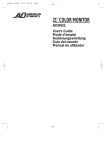


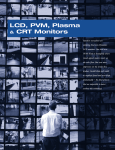
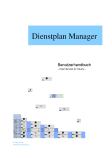

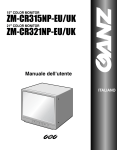
![Handbuch (deutsch) [PDF ]](http://vs1.manualzilla.com/store/data/006804687_1-349a3aed475e4eaa9b965dce892f30c9-150x150.png)
